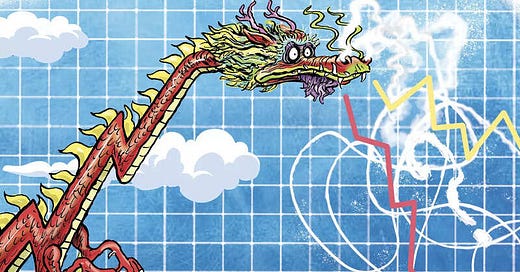The Red Giant Is Faltering—And America Should Take Note
The dragon that Washington elites swore would dominate the 21st century is coughing smoke.
By the spring of 2025, the narrative is wearing thin: China, the unstoppable economic force, is now bracing against headwinds it can no longer control.
Yes, Beijing reported 5.4% GDP growth in Q1—fueled by a short-term rebound in domestic spending and industrial activity. But don’t mistake movement for momentum. The IMF has slashed China’s full-year forecast to just 4%, pointing to U.S. tariffs and rising global trade uncertainty as the culprits. For a regime obsessed with projecting strength, this is a rare moment of exposed weakness.
Behind the headlines, China’s industrial machine is straining. In March, industrial output climbed 7.7%, up from 5.9% earlier in the year—a show of muscle. But it’s deceiving. Beneath that figure, factories are scaling back, workers are being furloughed, and supply chains are choking under the weight of U.S. tariffs exceeding 145%. This is not sustainable growth—it’s a smoke signal.
Trade tells the truth. In the first two months of 2025, exports rose a mere 2.3%—well short of projections. Even worse, imports dropped over 8%, a stark sign that both Chinese demand and global appetite for its goods are waning. This is the real cost of decades of offshoring American industry and feeding a rival power with Western capital.
Now the retaliation is here: China has imposed 125% tariffs on U.S. imports, inflaming a tariff war that is driving up prices, disrupting trade, and proving what many of us argued for years—dependence on Beijing is not strength, it’s strategic suicide.
At home, the foundations are cracking. The property sector—once the heart of China's fragile consumer dream—is in crisis. Half-built towers, bankrupt developers, and homebuyers left in limbo. Even the IMF is calling for Beijing to inject 5% of GDP over several years just to stabilize the market. That’s not a correction. That’s a rescue mission.
Worse still, China’s so-called "youth dividend" is eroding fast. Urban youth unemployment is officially at 16.1%—but the reality, many believe, is far higher. A generation with no jobs, no housing prospects, and no stake in the system is not just an economic issue—it’s a political time bomb.
In response, China is trying to pivot. Firms are shifting manufacturing to Korea, Japan, and Southeast Asia, dodging tariffs. The CCP is forging new economic partnerships in places like Kenya, hoping to build influence where the U.S. has abdicated its role. It’s a clear signal: China is no longer betting on the West—it’s betting on a new world order.
And yet, for all the maneuvering, the fact remains: Beijing’s model is breaking. It was built on Western indulgence, Wall Street greed, and a D.C. political class that outsourced American power for cheap goods and quarterly profits.
That era is ending.
For the United States, the lesson could not be more clear. Tariffs work. Industrial policy matters. Sovereignty is strength. If we stay the course—if we rebuild at home while resisting the siren song of global interdependence—we won’t just watch China struggle. We’ll lead again.
China’s economy isn’t collapsing. Not yet. But it’s stumbling, and for the first time in decades, America isn’t playing defense.
Now is the time to push.





Think this leads to China making any accelerated push to take Taiwan? I see people pointing to 2027 as the year China invades but maybe this trade talk makes them go earlier?